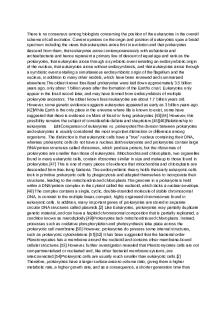5-Dietary Guidelines - Lecture notes 5 PDF

| Title | 5-Dietary Guidelines - Lecture notes 5 |
|---|---|
| Course | Food: Nutrition, Culture and Innovation |
| Institution | Deakin University |
| Pages | 2 |
| File Size | 60.2 KB |
| File Type | |
| Total Downloads | 1 |
| Total Views | 129 |
Summary
Summary of lecture and study notes...
Description
-
There are five guidelines in the Aus t r a l i a nDi e t a r yGui de l i ne s Most recent version- 2013 Guidelines make recommendations based only on whole foods rather than recommendations related to nutrients or other specific components of food. Different recommendations for people across the lifespan/ gender Special recommendations are also noted for people following specific dietary patterns, such as vegetarian or vegan dietary patterns.
Target audience for the Guidelines: - Health professionals (such as dietitians, nutritionists, general practitioners, nurses and lactation consultants) - Educators - Government policy makers - The food industry - Other interested parties Not specifically meant for use by the general population. Challenges - Understanding which nutrient to consume and how much of it. Dietary Guidelines The Australian Dietary Guidelines - Developed by the national health and Medical research council (NHMRC), a federal body, & revised and updated in 2013 Why? Australia has experiences an increase in diet related disease and these guidelines were developed to address this. Guideline 1 To achieve and maintain a healthy weight, be physically active and choose amounts of nutritious food and drinks to meet your energy needs. Children and adolescents should eat sufficient nutritious foods to grow and develop normally. They should be physically active every day and their growth should be checked regularly. Older people should eat nutritious foods and keep physically active to help maintain muscle strength and a healthy weight. Guideline 2 Enjoy a wide variety of nutritious foods from these five groups every day: Plenty of vegetables, including different types and colours, and legumes/beans Fruit Grain (cereal) foods, mostly wholegrain and/or high cereal fibre varieties, such as breads, cereals, rice, pasta, noodles, polenta, couscous, oats, quinoa and barley Lean meats and poultry, fish, eggs, tofu, nuts and seeds, and legumes/beans Milk, yoghurt, cheese and/or their alternatives, mostly reduced fat (reduced fat milks are not suitable for children under the age of 2 years) And drink plenty of water. Guideline 3 Limit intake of foods containing saturated fat, added salt, added sugars and alcohol. Limit intake of foods high in saturated fat such as many biscuits, cakes, pastries, pies, processed meats, commercial burgers, pizza, fried foods, potato chips, crisps and other savoury snacks. Replace high fat foods, which contain predominantly saturated fats such as butter, cream, cooking margarine, coconut and palm oil with foods, which contain predominantly polyunsaturated and monounsaturated fats such as oils, spreads, nut butters/pastes and avocado. Low fat diets are not suitable for children under the age of 2 years.
Limit intake of foods and drinks containing added salt. Read labels to choose lower sodium options among similar foods. Do not add salt to foods in cooking or at the table. Limit intake of foods and drinks containing added sugars such as confectionery, sugar-sweetened soft drinks and cordials, fruit drinks, vitamin waters, energy and sports drinks. If you choose to drink alcohol, limit intake. For women who are pregnant, planning a pregnancy or breastfeeding, not drinking alcohol is the safest option. Guideline 4 Encourage, support and promote breastfeeding. “...Is to support optimum infant nutrition by providing a review of the evidence and clear guidance on infant feeding for health workers. Guidance is based on evidence from the Australian Dietary Guidelines literature review and additional reviews specific to infant feeding.” Guideline 5 Care for your food; prepare and store it safely....
Similar Free PDFs

5 - Lecture notes 5
- 4 Pages

Chapter 5 - Lecture notes 5
- 15 Pages

Chapter-5 - Lecture notes 5
- 6 Pages

Chapter 5 - Lecture notes 5
- 83 Pages

Tutorial 5 - Lecture notes 5
- 3 Pages

Chapter 5 - Lecture notes 5
- 4 Pages

Imagen 5 - Lecture notes 5
- 1 Pages

Quiz 5 - Lecture notes 5
- 11 Pages

Chapter 5 - Lecture notes 5
- 20 Pages

Chapter 5 - Lecture notes 5
- 4 Pages

Lesson 5 - Lecture notes 5
- 22 Pages

5 Statehood - Lecture notes 5
- 4 Pages

Prokaryotes 5 - Lecture notes 5
- 2 Pages

5. Conduct - Lecture notes 5
- 4 Pages

5. Emotions - Lecture notes 5
- 8 Pages
Popular Institutions
- Tinajero National High School - Annex
- Politeknik Caltex Riau
- Yokohama City University
- SGT University
- University of Al-Qadisiyah
- Divine Word College of Vigan
- Techniek College Rotterdam
- Universidade de Santiago
- Universiti Teknologi MARA Cawangan Johor Kampus Pasir Gudang
- Poltekkes Kemenkes Yogyakarta
- Baguio City National High School
- Colegio san marcos
- preparatoria uno
- Centro de Bachillerato Tecnológico Industrial y de Servicios No. 107
- Dalian Maritime University
- Quang Trung Secondary School
- Colegio Tecnológico en Informática
- Corporación Regional de Educación Superior
- Grupo CEDVA
- Dar Al Uloom University
- Centro de Estudios Preuniversitarios de la Universidad Nacional de Ingeniería
- 上智大学
- Aakash International School, Nuna Majara
- San Felipe Neri Catholic School
- Kang Chiao International School - New Taipei City
- Misamis Occidental National High School
- Institución Educativa Escuela Normal Juan Ladrilleros
- Kolehiyo ng Pantukan
- Batanes State College
- Instituto Continental
- Sekolah Menengah Kejuruan Kesehatan Kaltara (Tarakan)
- Colegio de La Inmaculada Concepcion - Cebu
